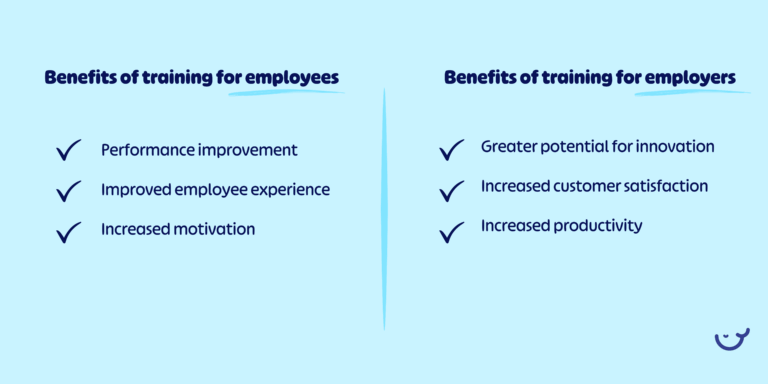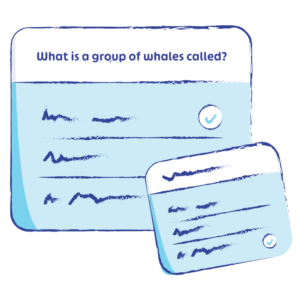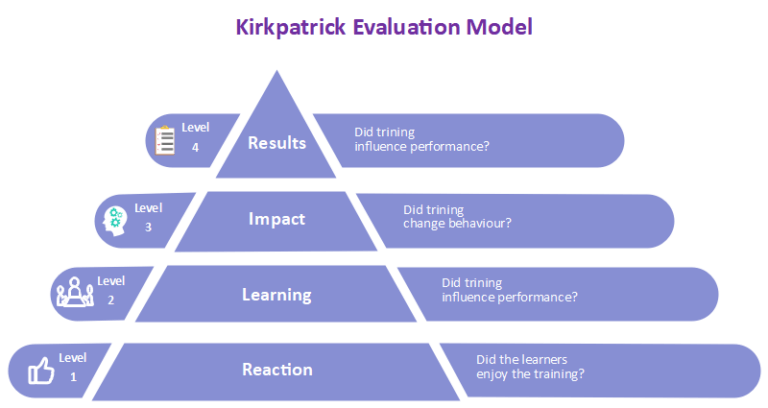Why measure employee training effectiveness?
Employee training is a significant investment. In 2022, U.S. companies spent over $100 billion on training programs. But how do you ensure that this investment actually delivers results?
Measuring employee training effectiveness is essential to:
✅ Improve employee performance, engagement, and retention
✅ Align learning with business goals
✅ Quantify ROI—ensuring that training is worth the investment
Let’s explore how to practically measure and enhance training effectiveness in your organization.
What Are the Benefits of Measuring Training Effectiveness?
Investing in employee development leads to:
📈 Higher productivity & innovation – Skilled employees perform better.
🛡️ Better retention rates – IBM found that 62% of employees stay longer at companies with strong training programs.
💡 Stronger employer brand – Attract top talent by showing commitment to growth.
With an increasing number of employees citing learning and development as a priority in job satisfaction, employee training is likely to be a big part of your talent retention strategy.
Key Performance Indicators (KPIs) to Measure Training Success
To evaluate training effectiveness, track both short-term and long-term KPIs, such as:
1. Learning Outcomes (Knowledge & Skill Retention)
✅ Assess knowledge retention via quizzes, tests, or case studies
✅ Track competency improvement using before-and-after assessments
2. Time-to-Competence for New Hires
✅ How quickly do new employees become productive?
✅ Compare onboarding time before and after training improvements
3. Job Performance Metrics
✅ Does training improve employee performance scores?
✅ Are trained employees achieving higher efficiency and fewer errors?
4. Employee Retention & Engagement
✅ Compare retention rates of trained vs. untrained employees
✅ Use employee Net Promoter Score (eNPS) to gauge satisfaction
5. ROI of Training Programs
✅ Calculate ROI: You can use our ROI Calculator.
✅ Track financial impact through productivity gains and error reduction
5 Steps to Measure Employee Training Effectiveness
Step 1: Set Clear Learning Goals
🔹 Define specific learning objectives for each role.
🔹 Align training goals with business objectives (e.g., reducing onboarding time).
🔹 Use aptitude tests like the Saville test to benchmark new hires’ skills.
💡 Example: A sales team training goal might be:
"Increase sales conversion rates by 15% within 3 months after training."
Step 2: Choose the Right KPIs & Benchmark Performance
🔹 Identify key metrics that directly impact business outcomes.
🔹 Set skill benchmarks for each role (e.g., customer service reps should handle X calls/day).
🔹 Track improvement through performance reviews and data analytics.
💡 Example: If onboarding takes 8 weeks, and post-training it takes 6 weeks, you’ve improved efficiency by 25%.
Step 3: Leverage Technology & Analytics
It’s easy to see why top teams utilize technology for team training.
🔹 Use a Learning Management Systems (LMS) to track training completion rates.
🔹 Analyze knowledge retention using built-in quizzes and feedback tools.
🔹 Utilize AI-driven training analytics software for deeper insights.
💡 Example: If knowledge retention rates drop below 60%, refreshers may be needed.
Step 4: Gather Employee Feedback
🔹 Conduct post-training surveys to assess training impact.
🔹 Use self-assessment questionnaires and peer feedback.
🔹 Ask:
- Was the training content easy to understand?
- Was it relevant to your daily tasks?
- What could be improved?
💡 Example: If 80% of employees say the training lacked hands-on exercises, update the program with real-world simulations.
Step 5: Continuously Improve Training Programs
The correlation between learning and retention is quite astonishing – According to LinkedIn’s 2023 Workplace Learning Report, one of the top 5 factors that employees consider when they’re looking for a new job is the opportunity to learn and develop new skills.
The more you update and continuously improve your employee training, the more likely you’re going to retain top talent.
🔹 Regularly review training materials for updates.
🔹 Track employee engagement with training content (video watch rates, interactive participation).
🔹 Adopt a blended learning approach (videos, microlearning, and real-world scenarios).
💡 Example: Netflix-style training with bite-sized, engaging content increases retention compared to 200-page manuals.
How to put employee training measurement into practice?
During the 1950s, the University of Wisconsin Professor Donald Kirkpatrick developed the Kirkpatrick Evaluation Model for evaluating training, which is still relevant today.
💡 Use the Kirkpatrick Model (a widely recognized framework for evaluating training impact):
🔹 Level 1: Reaction – Employee feedback (surveys, interviews).
🔹 Level 2: Learning – Test scores, quizzes, knowledge retention.
🔹 Level 3: Behavior – Job performance improvements, self-assessments.
🔹 Level 4: Results – Productivity gains, revenue impact, retention rates.
📌 Tip: You don’t need to measure everything—focus on what directly impacts your business goals
How to improve employee training effectiveness?
Before improving training effectiveness, you need to define clear objectives:
🔹 What skills should employees gain?
🔹 How does training align with business goals?
🔹 What success metrics will you track?
Once these are established, you can enhance your training strategy using the following methods:
1. Build a Knowledge Base for Continuous Learning 📚
🔹 According to the Forgetting Curve, people forget two-thirds of new knowledge within a day.
🔹 To combat knowledge loss, document training materials in a centralized, accessible knowledge base.
🔹 Use microlearning techniques (short, focused training) to improve retention.
💡 Example: Instead of long PDFs, create searchable SOPs, quick guides, and video explainers within an LMS.
2. Use Contextual Learning to Reinforce Skills 🎯
🔹 Employees learn best when training directly applies to their daily work.
🔹 Align training content with real-world scenarios and company processes.
🔹 Embed training resources within the apps employees use daily (e.g., CRM, project management tools).
💡 Example: A sales rep learning new techniques should practice in mock sales calls rather than just reading a guide.
3. Make Training Content Engaging—Ditch Boring Manuals 🎬
🔹 200-page manuals? Forget it! Employees prefer interactive, bite-sized learning.
🔹 Apply the "Netflix Effect"—use videos, animations, and gamification to boost engagement.
🔹 Leverage quizzes, simulations, and real-time feedback to keep learners involved.
💡 Example: Replace long PowerPoint slides with short training videos and interactive quizzes.
4. Leverage the Right Training Software & Tools 💻
🔹 Use an AI-powered Learning Management System (LMS) to track progress and engagement.
🔹 Choose software that automates assessments, collects feedback, and personalizes learning paths.
🔹 Ensure the tool integrates with your HR systems for seamless reporting.
💡 Example: Platforms like Whale, TalentLMS, and Docebo offer smart training automation and analytics.
Conclusion: Use an Employee Training Effectiveness Checklist ✅
Use this checklist to ensure training is measured and optimized:
✔️ Training aligns with business objectives
✔️ Employees have clear KPIs
✔️ We measure learning outcomes & engagement
✔️ Employee feedback is collected regularly
✔️ We have a data-driven approach to training decisions
✔️ ROI is quantified and analyzed
📌 Final Thought: Training isn’t just a one-time event—it’s an ongoing investment. Regular assessment ensures that training evolves with business needs and drives real impact.
FAQs about Employee Training Measurement
Why is it important to measure employee training effectiveness?
Measuring training effectiveness ensures that learning programs contribute to skill development, employee performance, and business growth. It also helps in quantifying ROI and identifying areas for improvement.
What are the best KPIs to track training effectiveness?
Key training KPIs include:
- Knowledge retention (quiz scores, assessments)
- Time-to-competence (onboarding duration)
- Job performance improvement
- Employee engagement & satisfaction
- Training ROI (return on investment)
What is the Kirkpatrick Model for training evaluation?
The Kirkpatrick Model is a four-level framework to measure training success:
1️⃣ Reaction – Employee feedback on training experience
2️⃣ Learning – Knowledge and skill acquisition
3️⃣ Behavior – Application of learned skills in the workplace
4️⃣ Results – Impact on productivity, retention, and business growth
How can I measure training ROI?
To calculate training ROI, use this formula:
Training Costs (Training Benefits−Training Costs) ×100
Compare productivity, efficiency, and error reduction before and after training.
How can I improve training retention?
- Use microlearning (short, focused lessons)
- Use drip learning with tools like Whale
- Provide interactive & contextual training
- Implement gamification & real-world scenarios
- Regularly reinforce learning with refresher courses
How often should training effectiveness be measured?
Regularly! Use real-time tracking tools and quarterly or bi-annual evaluations to continuously refine training programs.
Key Terms & Further Reading on Employee Training
Related blog posts
How the Best Teams use Employee Training Technology
Common employee training mistakes






